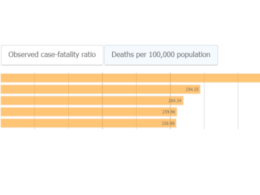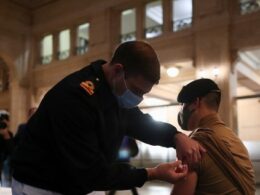BCG
by Joaquim Cardoso; Cristopher Daniel; Dan Kahn, and Amanda Brimmer.
June 23rd, 2021
On March 11th 2021, Brazil completed one year since de death of the first person due to the Covid-19 pandemic. During this period the country lost 273.124 lives. On March 24th Brazil reached 300 thousands deaths unfortunately, according to the official statistics, that some argue may be 40% higher.
On June 19th Brazil reached 500 thousands deaths, and very sadly, the number keeps growing and lives continue being lost, while the vaccination rate per million is low, when compared to other countries (even in Latin America).
The average forecasts for the for the month of June by IHME were, 373.897 deaths. Unfortunately the forecasts were closer to the pessimistic scenario. The occupancy rates of ICUs in Hospitals exceeds 80% of capacity in many states, and in several cases it is in the range of 100%.
The forecasts are that it will take more than a year until vaccines are available to all the country’s population of 212 million people, at current vaccination rate. Updated forecasts for the number of deaths from IHME for the end of September are in the range of 735 thousands. We better pay more attention, and improve action.
In face of this crisis, even catastrophic situation, we organized a series of Best Practices adopted by other countries and propose the following recommendations for rapid discussion, strategy formulation and rapid implementation for the leadership of the country, state and municipalities at the highest levels, and including all sectors of society.
1.The 1st recommendation is to build a National Governance System, Form 5 Crisis Committees, and Nominate Crisis Leaders in the 5 main critical areas
The Federal Government should:
(1) Form a “Pandemic Council”
(2) Form 5 “Crisis Committees”; and
(3) Nominate “Crisis Leaders” for 5 main critical areas:
(a) Vaccines;
(b) ICU Systems & Modular Hospitals;
(c) Supply Chain;
(d) Human Resources and
(e) Testing, Isolation and Monitoring.
The paper “Governing in the time of Coronavirus” (BCG, March 2020) stated that “based on our work in crisis management around the world, we have identified five common governance mistakes:
(a) Lack of Strategic Focus;
(b) Fragmented Collaboration;
(c) Competing Priorities;
(d) Insufficient Guidance on Daily Behaviors; and
(e) One-Sided Communication”.
“Several straightforward measures can make a significant difference in how effectively governments address COVID-19:
(a) Set up a war room;
(b) Identify a crisis manager;
(c) Empower the crisis manager;
(d) Overcommunicate”.
About the “Pandemic Council”, the main stakeholders of the society should participate, including the three spheres of government – Federal, State and Municipalities; main areas of Government – Health, Education, Technology and Economy; Academia; Industry, Business; Education; and 3rd Sector Organization for example. Government should also engage the Legislative and the Executive System. Without an efficient Governance Model, it is unlikely that the country will be successful in winning the fight against the disease. The Pandemic Council would work as forum to unite the Nation around solving the Pandemic Disaster.
On the topic of appointing “Crisis Leaders”, they should be appointed in at least 5 main critical areas: (1) Vaccines; (2) ICU Systems; (3) Supply Chain; (4) Human Resources and (5) Testing and Tracking
This strategy of nominating a Crisis Leader worked well in the USA when Joe Biden nominated Jeff Zients as a Vaccine Czar . One result achieved by Zient was an agreement between Merck and Johnson & Johnson to cooperate to speed the production of JNJ’s vaccine . In this sense, Merck retrofitted its manufacturing facilities to produce the vaccine at scale and to expedite the supply of key vaccine production materials to Johnson & Johnson. This partnership helped ensure the US has enough vaccine supply for every adult in America by the end of May, two months earlier than previously anticipated.
The Crisis Leader for Vaccines should update the vaccines plan with the latest developments, including both National production and Imported vaccines, as well partnerships among suppliers for adding manufacturing capacity.
We propose to expand the concept of a “Crisis Vaccine Leader”for the other 4 main areas listed above. The leaders of the other areas should follow the same steps listed before for vaccines, for their respective areas of responsibility.
2.The 2nd recommendation is to update the “Vaccines Plan”, to rapidly vaccinate the health vulnerable.
The scope of the Emergency Plan for Vaccines should include, Procurement, Development, Manufacturing, Partnerships and Roll Out. Recently Instituto Vital Brazil announced that it is negotiating with the Indian Institute Zydus Cadila, 100 million vaccine doses. This vaccine is not yet approved in Brazil. This alternative should be investigated with a very high priority, in parallel to the other alternatives (such as the recent announcement of USP Ribeirão Preto and Butanvac initiatives). In addition to that, the engagement with International and Global Initiatives, must also be considered. There are also proposals on the table from Animal Vaccines Manufactures that say they are able to convert production into Human Vaccines. This proposals should also be considered, alongside with alternatives to increase the supplies for vaccines.
Three recent findings have to be considered when updating the Vaccines Plan:
(1) All vaccines have proven effective at minimizing risk of most severe outcomes or death from Covid;
(2) Protecting the health vulnerable is the priority; and
(3) Consider a single jab strategy to inoculate as many health vulnerable people as possible while supply ramps up.
In the paper “A Vaccination Strategy to Save Lives and Livelihoods” (BCG, March, 2021), BCG’s specialists make the point that, beyond the immediate aim of vaccinate the health care workforce and the health vulnerable population, a COVID-19 vaccination strategy also needs to confront the dawning and daunting reality that COVID-19 is likely endemic. There are several reasons why we believe this will be the case. National COVID vaccination and containment strategies should recognize this reality. Governments should already be planning permanent processes to conduct sustained testing and perform regular booster shots, even as they work to rapidly vaccinate the vulnerable.
How do governments execute a strategy built around reducing the risk of serious disease rather than achieving herd immunity? It’s helpful to think of vaccination execution of consisting of three phases: rollout, ramp up, and end game. In each phase, the challenge is to dynamically match supply and demand. In the “rollout phase” the goal is simple: to get needles into the arms of those who are most health vulnerable.
Nations that are several months behind Israel, the UAE, UK, and US in rollout should seriously consider a “first doses first” strategy of vaccinating as many people as possible with their initial shots. The data suggest that booster shots can be delayed by up to 12 weeks. This strategy would stretch supply and reduce the risk of overrunning health system capacity. The UK has followed this approach to get an effective if not maximal level of protection for more people. Emerging evidence supports that decision: multiple studies out of Israel point to high levels of protection from the initial dose of vaccine while real-world evidence from the UK suggests 60% to 75% efficacy against symptoms in older adults after a single dose of either Pfizer or Astra Zeneca’s vaccine—and even higher efficacy against hospitalization and death. What’s more, the AstraZeneca vaccine appears even more effective when doses are spaced 12 weeks apart rather than four weeks.
The same steps for Diagnostic, Planning and Execution should be followed by the other Crisis Leaders in the other 3 areas mentioned before – ICU Systems; Testing and Tracking; and (4) Supply Chain & Human Resources – given the critical situation in this areas.
3.The 3rd recommendation is about Building Modular Hospitals & ICU Systems, that will remain as a legacy when the pandemic is over.
Brazilian Federal Government, States and Municipalities should consider building Modular Hospital Buildings with ICU beds, similar to the ones built by Brasil ao Cubo in São Paulo for Hospital Moyses Deutsch, a public municipal hospital, managed by Hospital Israelita Albert Einstein. Brasil ao Cubo built 100 ICU beds in only 40 days. The advantage of this solution is that this Hospital Beds will remain as a legacy for the population, when the pandemic is over.
Another strategy is to exchange patients and health care workers among cities as is currently being done. One strategy for consideration is importing ICU equipment from other countries where the pandemic is under control, and even giving temporary work permit for foreign health care professionals. Again, for that is necessary having a Central Planning and Control System.
Other lesson learned here is not to disassemble the Campaign Hospitals, before the pandemic is over. If we take the case of China for example, they assembled a 1.000 beds hospital in only 10 days (it was planned with antecedence), but once the 1st wave of the infection was over, they did not disassembled it. They disinfected the hospital and closed the installations. If there is a new surge of the pandemic, the Campaign Hospitals (Temporary Hospitals) are ready for being reopened.
4.The 4th recommendation is about “Supply Chain & Human Resources”.
The shortage of Supplies items such as PPE (Personal Protective Equipment), Oxygen, ICU Ventilators, Medicines and so on have been common since the beginning of the pandemic. The same is valid for Human Resources. We recommend this Committee be formed with the help from industry, logistics, software and all need specialized help. The management of resources from a centralized point Control Tower point of view is very important, and are the exchange and sharing of resources among cities, and the public and private system. One clear example of that is the current calamity situation of “oxygen” supplies.
5.The 5th recommendation is about “Testing, Isolation and Monitoring”.
It will take many months, even more than a year, before vaccines are available to all the population. It is important to emphasize that testing continues to be a crucial pillar any comprehensive response to the pandemic. Since COVID-19 isn’t going to be eradicated any time soon, we will need to maintain a significant testing capacity and capability for a number of years after a highly efficacious vaccine has become commonly available.
In the paper “Vaccines aren’t the end of the fight, but the end of the beginning” (BCG, Oct. 2020) , even with a highly successful vaccine, the population will still be wearing masks, maintaining distance, and avoiding crowds for many months after regulatory authorization. In this way, testing, tracing, and continuing efforts to reduce the severity of the disease with therapeutics will also remain crucial. Countries, regions, and states still have time to get this right through science, hard work, and vigilance.
The paper “As Vaccines Roll Out, Testing Still Matters” (BCG, Jan. 2021) makes the point that even with all the expectations of the vaccines coming to the market, we still need to employ other tools from the COVID-19 response toolbox for some time to come. In this context, the most important of these is testing. Rolling out vaccines and improving therapeutics will help us accelerate the fight, while crush-and-contain strategies and smart government policies will help manage further impact. The reality is that vaccines will initially be a scarce resource, and they may or may not be deployed to maximize public health.
When the number of infections cases is lower, we should consider use technology to identify and track the people with whom infected people had contact and engaging Community Health Workers (CHW), to help on this task. Brazil has more than 286.000 thousands of CHW, that could be leveraged to this task, with the help of Telemedicine and Digital Screening Systems.
6.The 6th recommendation is in the area of “Vulnerable Population, and Emergency Aid”.
In the paper “Protect the vulnerable, protect us all” (BCG, Jun. 2020) it is defined that the three primary groups of vulnerable individuals are the following: (1) Those who are susceptible to adverse health outcomes; (2) those who are vulnerable to exposure; and (3) those who suffer economic hardships.
In the paper “A High-Return Strategy for a Safer Reopening” (BCG, July 2020) BCG has identified a package of five policies that collectively work toward protecting the four groups of the health vulnerable: (1) Masks and behavior; (2) Sentinel Testing; (3) Supporting for Shelter in Place; (4) Accommodating the Health Vulnerable at Work; and (5) Embracing Suitable Standards and Practices for Congregate Living. The estimates that follow are based in the USA context, but the principles are also applicable to Brazil.
Masks and Behavior. At least in the US, wearing a mask has become a partisan political issue, but that distressing development obscures the fact that small changes in behavior can have an outsize effect in bringing the reinfection rate of the coronavirus below 1.0 so that the virus will eventually cease to spread.
Governments should pay for masks for the health vulnerable and should design and execute behavioral campaigns to encourage the vulnerable to wear them.
Maskwearing is the highest-ROI policy. We estimate (for the USA) that if 80% of the health vulnerable wore high-quality masks in public, COVID-19 hospitalizations could fall by nearly 50%. Even simple face coverings are effective, especially in indoor spaces, where transmission is estimated to be 10 to 20 times higher than outdoors. They are also cheap.
Sentinel Testing. Testing has the second-highest ROI of the five policies and could reduce hospitalizations by up to 25%. The first priority is to test people with symptoms that are severe enough to warrant hospitalization and people who are in contact with confirmed cases. After dealing with those instances of urgent testing, governments should focus on sentinel or random testing of the health vulnerable and of those who are close to them—including workers, such as long-term care staff, who come into contact with them. Governments should also rapidly embrace pooled testing, a technique that combines multiple samples and tests them in a single batch, to stretch scarce resources.
Support for Sheltering in Place. This policy—which applies to all four health-vulnerable groups—aims to incentivize people to stay home by delivering resources to their door and combating feelings of isolation and loneliness while they stay home. Governments should encourage and incentivize companies to offer subsidized services—especially meal and grocery deliveries and online mental health consultations—to the health vulnerable. An 80% reduction from pre-pandemic levels in contact between the health vulnerable and the outside world could reduce hospitalizations by nearly 20%.
This policy is especially relevant for the elderly, who may need help in adapting to the online and contactless world. Because many people trust their faith communities, local nonprofit organizations, and peer groups more than they do their government, leaders should include these groups in planning and executing their shelter-in-place campaigns. The UK has adopted this approach and used it in delivering more than 1 million boxes of food. Ireland is investing in mental health services. In many countries, stores have set aside special hours for the elderly and the vulnerable to shop so that they can avoid large crowds. Depending on the level of local community transmission, this policy could be turned on and off as needed, making it even more affordable.
Accommodating the Health Vulnerable at Work. As lockdown orders have expired, workers have returned to jobs that require their physical presence, such as in stores, factories, meatpacking plants, agricultural fields, offices, restaurants, and amusement parks. Risks abound in these settings, as demonstrated by the outbreak in Europe’s largest meatpacking plant, in Gütersloh, Germany. In that instance, the failure of the private sector to protect workers and of the public sector to enforce worker safety boomeranged back to the general public, which was forced to live under a soft local lockdown after the outbreak.
The fact that a significant portion of the workforce is health vulnerable poses a major challenge for public-sector and private-sector leaders. Governments and employers around the world have focused on such measures as testing and screening; safety protocols involving Plexiglas, protective equipment, and distancing; and staggered shifts.
Government should encourage and incentivize the private sector, especially small and medium businesses, to develop processes to minimize physical contact (like Orizon did in the USA), and develop other policies. We know what works: adopting safety protocols and checks; enabling employees to move voluntarily from high- to low-contact jobs (from the cash register to the stockroom); and maximizing commute safety.
Protecting employees in this way would reduce hospitalizations as much as would similarly protect the workers who are not health vulnerable.
Embracing Suitable Standards and Practices for Congregate Living. People who live in congregate settings account for a tragically large share of the death and suffering inflicted by COVID-19, despite amounting to a total population of less than 5 million in the US. Adding more protections for this group of people would will have a low cost and would reduce overall hospitalizations by up to 9%. The success of South Korea and other countries in dealing with this population provides real-world evidence of what works. In long-term care facilities, policies should rigorously limit outside visits, create spaces for quarantining, and test workers at least weekly. South Korea, for example, protects patients by closely monitoring the health and travel histories of staff and visitors and by incentivizing health and safety through government reimbursement. These policies have helped prevent new outbreaks.
Dormitories are an especially critical setting. Outbreaks have occurred in worker dorms, and colleges and universities that reopen in the fall will confront similar challenges in identifying, isolating, and treating infected students. Although relatively few college students are health vulnerable, they circulate in the broader economy and may have health-vulnerable family members.
7.The 7th recommendation is on the area of “Social Distancing and Public Transportation System”.
Combining social distance strategies with public transport has been a challenge for current governments. While COVID-19 pandemic has forced cities around the world to implement stringent physical distancing measures, many of them have needed to maintain public transport services for essential workers. The world bank recommends many measures can be taken to reduce the risk of contagion, such as: (1) Disinfection; (2) Physical distancing; (3) Communications; (4) Contact tracing technology.
Additional strategies could be developed here, such as contracting private transportation capacity (Vans, Chartered Buses [fretado], Uber, and so on), in a similar way that the Public Health Systems is contracting ICU beds from the Private Health System. There is no point in issuing a social distancing policy, if specific policies for social distancing are not implemented at the Public Transportation System. Distributing the opening and closing time of business activities in several phases (7am, 9am, and so on), can also help lower the demand for transport in peak times.
8.The 8th recommendation is on the area of “Digital, Data & Analytics Solutions” in general.
The paper “Five Lessons from the Pandemic for Health Care Systems” (BCG, Dec. 2020) makes the point about Digital Solutions is that countries that had a stronger foundation in terms of digital technology before the pandemic it were far better equipped to respond to it. For example, Norway and Finland both had scalable, flexible digital infrastructure in place for their national health systems, which dramatically accelerated their rollout of coronavirus response measures.
Other health systems that may not have had such an infrastructure in place before the coronavirus have taken noteworthy steps to close the gap. For example, Dubai rolled out a telehealth app that offers free voice and video consultations around the clock. And the European Union announced a €56 million initiative in May for digital tools, including artificial intelligence. Therefore, Health Care Systems need to continue investing in and enabling solutions that allow them to manage subsequent waves of the pandemic or future pandemics.
Brazil needs specific action on a Data Collection Systems, to capture information about number of cases, number of deaths, causes of deaths, and so on. Another specific solution needed is on Electronic Immunization Registry (EIR) for Covid-19, that should remain as a legacy for other vaccines as well. Unless we have a such, we’ll soon start facing problems for the application of the 2nd dose of the vaccine, considering the country has adopted several vaccine brands, if we do not have the register of which vaccine was applied in the 1st dos, as we don’t know yet if it is possible to mix different brands of vaccines. This Digital, Data & Analytic Solutions are a must for effective planning and execution of successful pandemic programs.
One final point about digital solutions is that it’s also time for Brazil to enter the “Digital Surveillance Era”, in the face of current virus mutation. In January at a World Health Organization forum this week, Maria Van Kerkhove, an infectious-disease researcher at the agency, called on countries to increase their genomic surveillance, among other recommendations.
9.The 9th recommendation is on the area of “Communication”.
We emphasize here the recommendations made in the paper “Governing in the time of Pandemic (BCG, Mar.2020) about the topic of communication: “Overcommunicate – The worst thing that can happen to a government in a crisis is to lose the public’s trust. To maintain trust, governments should: (1) Sensitively take into account the psychological effects; (2) Overcommunicate and tell the truth.
Countries need massive, unified mobilization analogous to a wartime effort to roll out vaccines and therapeutics while simultaneously maintaining the daily fight using masks, distancing, virus monitoring, and other interventions. In this new context, in an interconnected world of global trade and tourism, fully restoring a country’s economic, social, and public health depends on a global recovery that includes all nations.
In the face of the current catastrophe were we are losing lives healthcare professionals are burned out, and the we situation is getting worst, we need urgent leadership and strategic action now.
10.The 10th recommendation is in the area of “Gaining the Trust” of the population.
In the paper “The Role of Trust in the COVID-19 Economic Recovery: Lessons from Asia” (BCG, May 2020) the authors make the point that “The severity of this economic downturn depends on the length and depth (distance from full operation) of the transition phase. We argue that trust will play a crucial role in limiting both”.
Trust is essential for a strong economic recovery. COVID-19 is testing not only the systemic resilience but also the adaptability of businesses, institutions, governments, and entire societies. The fabric of trust provides the means by which systemic coordination and cooperation can be achieved. Such cooperation can drive behaviors that, although uncomfortable, are essential to bring an economy back up to speed.
Trust is essential for businesses to regain capacity to operate. Employees need to go back to work, but they may not immediately trust the safety of their business environment. Measures such as temperature checks and social distancing in workplaces can help. But trust is also crucial to drive customer demand.
Finally, trust will be crucial to enable certain orchestrating institutions to function again. Consider, for example, public transportation, which is so essential to many people’s commutes. With typically crowded systems, people may be hesitant to return to old habits. Systematically checking temperatures and reducing capacity can help maintain commuters’ trust.
We define trust as “the expectation that a target agent upon which trust is placed will deliver on promises and/or behave according to expectations or agreed-upon shared norms.” Trust is driven by several elements, which we have grouped into four clusters. Making choices on the combination of these drivers will play a crucial role in the rebound.
Western governments need to take lessons on trust from Asia. Any lesson, of course, needs to be adapted to the West, according to the context:
(a) Transparency: Sharing information is clearly instrumental for building trust. Real-time information on both the spread of the virus and the rebound should be the goal;
(b) Security/Privacy: Privacy and security clearly have the potential to break, as well as build, trust. In the current uncertain environments, a static approach will not suffice
(c) Reliability/Credibility: Delivering on promises in a consistent manner will be essential going forward. In this regard, honest communication and long-term planning can help; and
(d) Proximity/Intimacy: Trust among communities has the potential to coordinate actions toward a common goal in an effective manner. For details about each lesson, refer to the paper mentioned.
CONCLUSION – SUMMARY OF THE 1O POINTS:
1.The 1st recommendation is to build a National Governance System, Form 5 Crisis Committees, and Nominate Crisis Leaders in the 5 main critical areas
(a) Vaccines; (b) ICU Systems & Modular Hospitals; (c) Supply Chain; (d) Human Resources and (e) Testing, Isolation and Monitoring.
2.The 2nd recommendation is to update the “Vaccines Plan”, to rapidly vaccinate the health vulnerable.
3.The 3rd recommendation is about Building Modular Hospitals & ICU Systems, that will remain as a legacy when the pandemic is over.
4.The 4th recommendation is about “Supply Chain & Human Resources”.
5.The 5th recommendation is about “Testing, Isolation and Monitoring”.
6.The 6th recommendation is in the area of “Vulnerable Population, and Emergency Aid”.
7.The 7th recommendation is on the area of “Social Distancing and Public Transportation System”.
8.The 8th recommendation is on the area of “Digital, Data & Analytics Solutions” in general.
9.The 9th recommendation is on the area of “Communication”.
10.The 10th recommendation is in the area of “Gaining the Trust” of the population.
About the authors
Joaquim Cardoso, Senior Advisor for Health Care Strategy & Transformation, BCG Brazil, São Paulo Office
Cristopher Daniel, Managing Director & Partner, Middle East, Dubai
Dahn Kahn, Principal, Chicago
Amanda Brimmer, Managing Director & Partner, Chicago
Acknowledgements
We acknowledge the contribution of all other colleagues from BCG, who wrote the previous papers that served for the initial basis for this specific paper.












